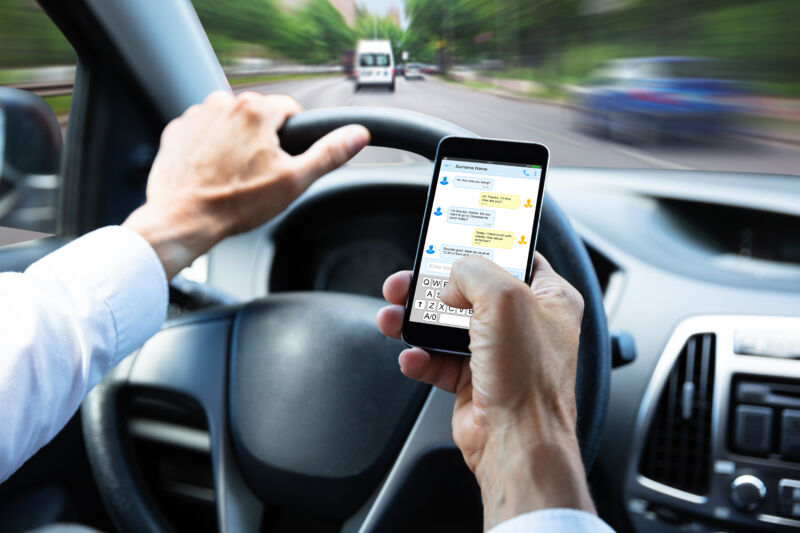
Enlarge / You should not do this while you are driving.
Getty Images
Distracted driving isn’t only a result of drivers using their phones when they should be paying attention. But it is a significant cause of the problem, accounting for at least 13 percent of distracted driving deaths and rising to 1 in 5 for young drivers. Now, a study conducted with customers of the Progressive insurance company has tested different strategies to get those drivers to put their phones down in the car, and it found two that significantly reduced handheld use, with the effect persisting after the end of the study.
The study recruited 1,653 customers already enrolled in its Progressive Snapshot program, which involves the use of a smartphone app that detects phone use while driving. Before the start of the trial, the participants all averaged more than 6.4 minutes per hour of handheld use while driving—Progressive says its safest customers have handheld usage of less than 1 minute per hour while driving.
Five test groups
The drivers were split into five different arms, each with increasing amounts of intervention. The first group just received education about the problem, such as statistics about state laws that ban phone use while driving, increased crash risks, and recommendations to use hands-free options like a phone mount or casting interface instead.
The second arm received the educational materials and a free phone mount with the message “Driving? Park your phone here.” The authors were particularly interested to see whether this arm worked, given the relatively low-cost and one-time nature of this intervention.
The third arm received both educational materials and the mount, but the participants were also asked to commit in writing to reducing their phone use while driving. The researchers informed these participants about their baseline phone use while driving and then gave them weekly goals to reduce their phone use to below 1 minute per hour over the course of the 10-week study. This arm also got regular tips on helpful habits, like mindfulness reminders, encouraging prompts, or using a phone’s “do not disturb” mode while driving.
Arm four included all the same interventions as arm three but added competitive gamification as well. Each Monday evening during the 10-week trial, the participants in arm four received a message with their handheld usage goal for the coming week and whether they met the previous week’s goal. Points were awarded for meeting the goal and were taken away for backsliding. Additionally, participants with similar baseline usage were grouped together in tens to form leaderboards so individuals could compete against (anonymized) peers.
Finally, arm five included the same interventions as arm four and added a financial incentive. Participants who scored enough points over the course of the 10-week study shared a $2,000 prize, each taking home $15.63 in the end. This arm was also told they would earn $5 for finishing at the head of the weekly leaderboard, which displayed a “total winnings” column in this arm.
What worked?
Perhaps unsurprisingly, none of the interventions in groups one, two, or three resulted in those participants significantly reducing their handheld use while driving. But the drivers in arm four had a 20.5 percent reduction in the amount of handheld usage while driving during the study.
What’s more, this effect persisted throughout the rest of the Progressive Snapshot period (a variable-length post-intervention period lasting 25–65 days) following the end of the 10-week study, with this arm still showing 16.2 percent less handheld usage compared to the control.
Paying drivers on top of competitive gamification was the most effective way to get them to put down their phones. This group reduced its handheld usage by 27.6 percent, or 89 seconds/hour, compared to the control. That reduction was maintained at the same level throughout the post-intervention period for this arm.
Gamification has already been adopted to varying degrees of success by automakers and their UI designers to try to encourage hybrid and EV drivers to be more efficient. So it’s not entirely surprising to see the same approach can work to modify other types of driving behavior. It’s even possible that insurance companies could start financially incentivizing drivers to behave better, assuming prizes cost less than the amount saved by paying for fewer crashes and claims.
PNAS, 2024. DOI: 10.1073/pnas.2320603121 (About DOIs).